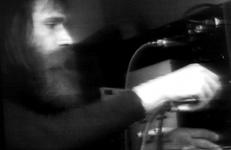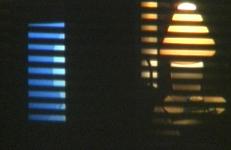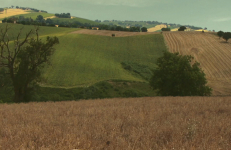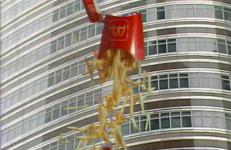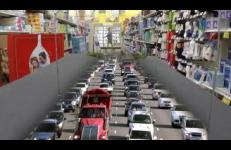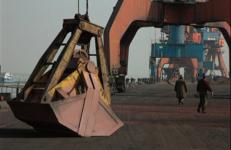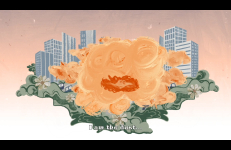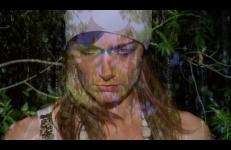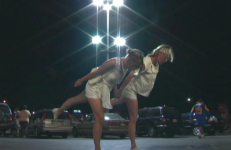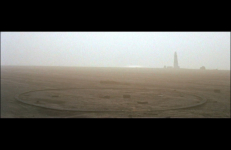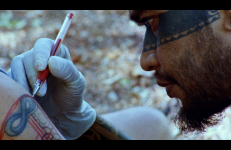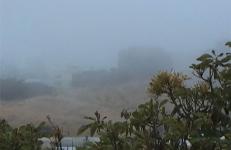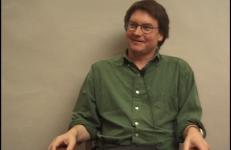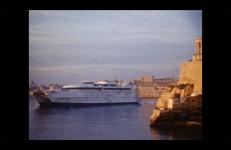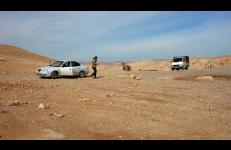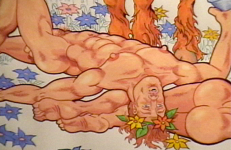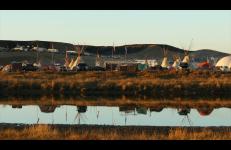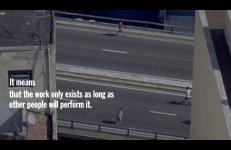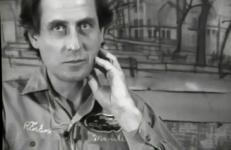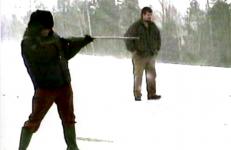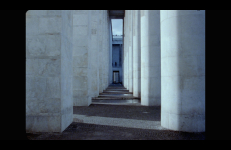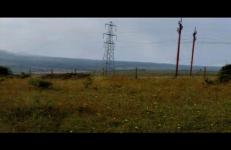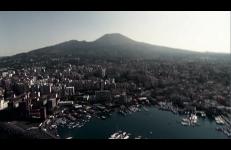In this video the artist states that a public work demonstrates what qualifies as art within his conception. Like Beached, it was also shot in a marshy area near the sea and in sequences separated by dissolves. One sees five different actions related to Broken Off. The artist breaks a tree branch, scrapes and kicks the ground with his foot, snaps a stick in two on a fence, scrapes a stone with his fingernail. At the end he pulls the line plug from the video, drawing attention to the mechanics of the medium.
Landscape
"...a rumination, a series of borrowed 'dialogues' out of an ongoing argument with myself. It meanders, mentally and physically, reflecting on the conditions of being human; on transience, consciousness and desire. It uses landscapes as provocations, as sites of contemplation. And between the landscape and the thought, i.e. between the radical presence of the physical world and the idea, there is, more often than not, a distance, disbelief or irony."
–– Ken Kobland
Neither a Sierra snowfield nor a tunnel proves to be the perfect studio space for the improvement of one’s craft. Only practice counts.
This title is also available on Sympathetic Vibrations: The Videoworks of Paul Kos.
Sequences of landscapes shot in an area of 60 km make up mosaics of places and reference axes constantly changing that do not exist in our surroundings. In this video bodies are not near or far. They are large or small. The horizons change and no space is independent from the viewer. Incorporating only memory, the landscape is seen in a variety of speeds and movements that apply a bodily logic to the vision.
MICA-TV creates a video format to express the idea of verticality and optimism common to the work of artists Dike Blair, Dan Graham, and Christian Marclay. Using a 360-degree camera rig to create a seamless revolving background of vertical camera moves, the video integrates the work of these artists who deconstruct and then reassemble elements of our culture to create their work.
A fairy tale, a road movie, a folly. The image of the road — black-top and broken white line — the most familiar and most fantastic sculptural installation; a worldwide work of art, which one sees everywhere and generally files under: "Are We There Yet?"
China Town traces copper mining and production from an open pit mine in Nevada to a smelter in China, where the semi-processed ore is sent to be smelted and refined. Considering what it actually means to "be wired" and in turn, to be connected, in today's global economic system, the video follows the detailed production process that transforms raw ore into copper wire--in this case, the literal digging of a hole to China--and the generation of waste and of power that grows in both countries as byproduct.
China, Beijing, I Love You! is an animated film about extraction of nickel and cobalt along China's Maritime Silk Road. The film focuses on the character of NICKEL DUST who is exiled from her home in Sulawesi Island due to nickel excavations there. On the other side of the world, in the Democratic Republic of Congo, cobalt is being extracted by artisanal miners. Both nickel and cobalt are the main components of batteries used in Electric Vehicle(EV) and mobile phones.
In a broken near future, a band of listless vagabonds ambles across a war-torn coastal territory, supervised and sorted by a group of idle soldiers. Rummaging, stuttering, and smashing through the leftovers of Western culture, these ragged souls conjure an unstable magic, fueled by their own apathy and the poisonous histories imbedded in their unearthed junk. Suspicion, boredom, garbage, and glamour conspire in the languid pageantry of ruin. Feel the breeze in your hair, and the world crumbling through your fingers.
C.L.U.E. (color location ultimate experience), Part 1 is a collaborative video and performance work by artists A.L. Steiner and robbinschilds, with AJ Blandford and Seattle-based band Kinski. Inhabiting the intersection of human movement and architecture, A.L. Steiner and robbinschilds (Sonya Robbins and Layla Childs) present a full-spectrum video, set to a score by rock quartet Kinski.
C.L.U.E. (color location ultimate experience), Part 1 is a collaborative video and performance work by artists A.L. Steiner and robbinschilds, with AJ Blandford and Seattle-based band Kinski. Inhabiting the intersection of human movement and architecture, A.L. Steiner and robbinschilds (Sonya Robbins and Layla Childs) present a full-spectrum video, set to a score by rock quartet Kinski.
Cobra Mist explores the relationship between the coastal landscape of Orford Ness and its traces of military history, particularly the extraordinary ruined architecture of experimental radar and the Atomic Weapons Research Establishment. Still under the official secrets act, much of what took place on the Ness will only be revealed over time. Military buildings have been left to the elements to deteriorate, creating a tension between the time it will take for their secrets to come out and for the buildings to disappear.
A synaesthetic S16mm portrait made between French Polynesia and the French province of Bretagne, Color-Blind recruits the restless ghost of Paul Gauguin as an uneasy spirit guide in excavating the colonial legacy of a decidedly syncretic post-colonial present.
A poetic meditation on distance, Come Closer is a short and peripatetic film, casting an affective web between the locations of Lisbon, San Francisco and Brazil. Focusing on Brazilian-Algerian filmmaker Karim Aïnouz, musician Derrick Green –– the filmmaker’s brother and lead singer of Brazilian band Sepultura –– and her own work produced in Lisbon since 1992, Come Closer can be thought as a meditation on friendship and saudade.
Matthew Coolidge is a founder and director of The Center for Land Use Interpretation (CLUI), an organization dedicated to raising awareness about how land is apportioned, used and perceived by its inhabitants. Through exhibitions, publications, and guided tours, Coolidge and the CLUI seek to foster and encourage a heightened sense of awareness of natural surroundings. In this interview, Coolidge defines a ‘land art spillover effect,’ in which the perceived significance of the landscape seems to increase the closer people get to a piece of environmental art.
A hypnosis-inducing pan-geographic shuttle built on brainwave-generating binaural beats, Deep Sleep takes us on a journey through the sound waves of Gaza to travel between different sights of modern ruin. Restricted from travel to Palestine, I learned auto-hypnosis for the purpose of bi-locating. What results is a journey, recorded on Super 8mm film, to the ruins of ancient civilizations embedded in modern civilization in ruins, to a site ruined beyond evidence of civilization.
In the midst of the 2011 revolution in Cairo, a few beduins listen to their car's radio near Jericho, a place which looks like the end of the world. Within moments this desolated landscape transfers into a busy tourist attraction as a bus full of Polish Pilgrims enter the landscape.
Note: This title is intended by the artist to be viewed in High Definition. While DVD format is available to enable accessibility, VDB recommends presentation on Blu-ray or HD digital file.
Strap on your back-pack and enter green spaces where a Satyr behind each tree lures you to "Rabbit Holes" you might not be able to get out of.
This title comprises Romance (2004), Day Dreaming (2004), and Molly's MayPole (2005) which were compiled into this form by Mike Kuchar in 2022.
An incomplete and imperfect portrait of reflections from Standing Rock. Cleo Keahna recounts his experiences entering, being at, and leaving the camp and the difficulties and the reluctance in looking back with a clear and critical eye. Terry Running Wild describes what his camp is like, and what he hopes it will become.
Rosa Barba’s work Disseminate and Hold investigates man-made geographies and landscapes, and how these are often deeply enmeshed with political agendas and utopian visions.
Rackstraw Downes’s “observation” paintings, executed on-site at ponds, intersections, and baseball parks, began as a mischievous response to the dogma of style and modernist criticism.
“There was a tremendous intellectual back-up, essentially against a lot of the figurative painting being done in the ’60s,” Downes says in this interview with Robert Storr. “If I show my slides in an art school I’ll get, 'Your paintings are very nice but how can you go backwards from Cézanne?’”
"This movie was collected for four years before being sprayed scattershot over 28 minutes of psychic mayhem. The line between living and dead is a frontier crossed and re-crossed here. The living are dead while the dead are animated, breathing, swimming, giving birth. Consumed by the animal life of the city, the artist undertakes a first person journey, producing diary notes from one of the most skilled lens masters of the new generation. The camera is her company in this duet of death, the instrument that permits her to see the impossible, the unbearable, the invisible."
E42 is a cinematic exploration of the area in Rome knows as the EUR, a modernist landscape that was originally designated by Mussolini as the the site of the World Fair of 1942 and as a celebration of the 20 year anniversary of Fascism. Originally designed as a monumental space for public performance and collective acts of solidarity to the Fascist regime, this landscape was in fact never inaugurated.
Earthmoves is a continuation of Semiconductor's exploration into how unseen forces affect the fabric of our world. The limits of human perception are exposed, revealing a world which is unstable and in a constant state of animation as the forces of acoustic waves come into play on our surroundings.
"Living on the slopes of the volcano Vesuvius is a strange contradiction: always in stress and yet also sleepy, waiting for what might happen. In close cooperation with the Osservatorio Vesuviano and several inhabitants of the 'Red Zone' of the volcano, Rosa Barba constructs a lyrical portrait of this area, which shelters Mafia members and illegal Chinese immigrants. Historic footage, measurements, maps, and aerial shots try to capture what is always uncertain."




